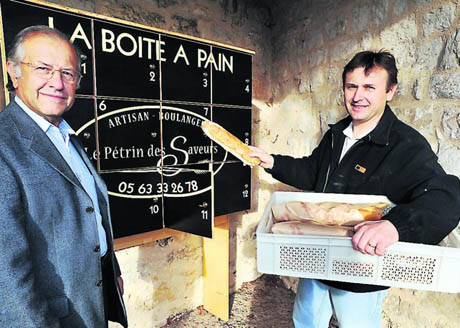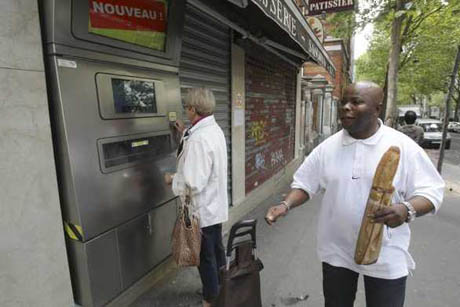
IMAGE: Damien Petit and his “Boîte A Pain,” photo by La Dépêche du Midi.
Both natives and non-natives alike tend to agree that bread is central to French cuisine, history, and national identity. Indeed, Steven Kaplan, a Cornell University professor who has spent the past forty years studying French society through its bread, argues that, historically, it was “impossible for the French to conceive of their well-being, here and now or hereafter, outside the confines imposed by the bread paradigm.”
Bread formed the base of the traditional French diet for centuries (Kaplan cites the Encyclopédie méthodique, which claims that, even if there are other foods available, “the bulk of the people believe they are dying of hunger if they do not have bread”), and the resulting “breadways” — the local boulangerie, national wheat policy, and a way of life structured around the daily production, purchase, and consumption of fresh bread — have shaped the French landscape, literally as well as psychologically, economically, and politically.

IMAGE: Steve Kaplan sniffing a baguette on the Conan O’Brien show (Kaplan dismissed Conan’s assertion that it “smells like bread” as “a tautology that non-believers are locked into,” claiming instead to detect winter vegetables, hazelnut, and butterscotch in his baguette).
The future of French bread is thus a matter of national concern, and the disappearance of more than 13,000 bakeries from towns and villages across the country over the last thirty years of the twentieth century signals, at least to the pessimistic, the rapid decline of a once glorious civilisation. Alarmed, the French government has legislated the composition of the baguette (in a 1993 ruling excluding preservatives), the definition of a bakery (bread must be made from scratch on the premises, no factory-frozen dough allowed), and even the timing of Parisian bakers’ August holidays, to ensure citizens are not stranded without bread.

IMAGE: A baguette vending machine in Paris, installed a year ago to allow the baker to go on holiday more often. Photo by Michel Euler/AP.
Nonetheless, French villages continue to lose their bakeries, and even their local “depôt de pain,” or general store to which the nearest baker would deliver fresh bread daily. According to Damien Petit, a baker in the southwestern French town of Gaillac, it is a given that opening a bakery in a small village is not profitable and that even door-to-door delivery to rural customers would operate at a loss. Instead, to capitalise on consumer demand in the breadless villages around Gaillac, Petit has come up with a P.O. Box for bread — a dozen locked boxes, installed on the central square, which he fills with customer orders of bread, pastries, and even the local newspaper before 9:30 every morning, ready to be picked up at the key-holders’ convenience.
If bakeries can no longer be found in the villages, then bread must come to them, explains local journalist Patrice Scoccia, and this compromise between home delivery and a fixed shop might well be the way to do it. Petit installed his first boîte à pain in November, and has already set up two more in neighbouring Senouillac (population 1,047). “Si la mayonnaise prend,” adds Petit (a lovely French expression that roughly translates to “if it takes”), he can imagine expanding to isolated communities throughout the region — and perhaps sharing his breadboxes with libraries, chemists, and other businesses. The boxes could even become a meeting point for residents, in a civic life-enhancing combination of essential services and water-cooler gossip.
Borrowing the business model of the post-office box to give rural populations access to fresh, artisanal bread and fill in the gaps left by a profit-oriented food supply system is an ingenious idea (and undoubtedly already occurs elsewhere). It’s also a compelling example of the potential that de-anchoring services from the static cartography of a fixed storefront holds to reconfigure diet, public space, and the food system itself.
[NOTE: Thanks to Jim Chevalier for posting the “Boîte à Pain” story to the Association for the Study of Food and Society listserv.]

